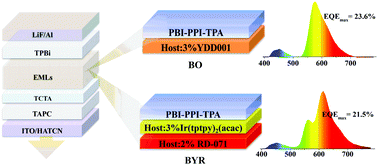Highly efficient fluorescence/phosphorescence hybrid white organic light-emitting devices based on a bipolar blue emitter to precisely control charges and excitons†
Abstract
Hybrid white organic light-emitting diodes (WOLEDs) combining blue fluorophores and green/red (or yellow) phosphors are still preferred for OLED production applications due to their advantages of good stability and high efficiency. One major challenge is to have a suitable blue fluorophore material to fully utilize the electrically generated excitons for fluorophore and phosphor emitters. Here, we employed an efficient blue fluorophore (PBI-PPI-TPA) with a high triplet energy of 2.48 eV as the blue emitter as well as the host for phosphors, whereby a series of highly efficient hybrid WOLEDs were successfully achieved. The two-color (BO) WOLEDs exhibited a maximum forward-viewing EQE/PE of up to 23.6%/77.8 lm W−1, and retained 20.0%/49.5 lm W−1 at 1000 cd m−2, thus exhibiting high-efficiency and low-efficiency roll-off. Furthermore, three-color (BYR) hybrid WOLEDs were also fabricated by adopting blue-yellow-red cascade energy transfer to ensure that all the excitons could be effectively utilized for the white emission. The resulting devices achieved a peak EQE/PE of 21.5%/53.2 lm W−1, retained 17.2%/26.8 lm W−1 at 1000 cd m−2, and the color rendering index (CRI) was doubled with respect to the two-color WOLEDs, showing a good trade-off between the efficiency and CRI. All these results are among the best reported for hybrid WOLEDs.



 Please wait while we load your content...
Please wait while we load your content...